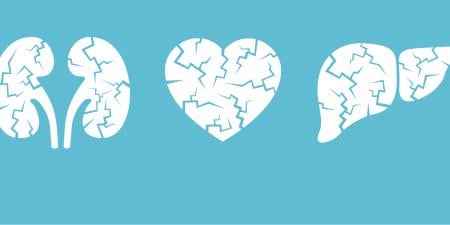Merion RM, Sharma P, Mathur AK, Schaubel DE. Evidence-Based Development of Liver Allocation: A Review. Transpl Int. 2011;24(10):965-972.
Liver transplantation has rapidly progressed from an experimental procedure to a lifesaving operation for patients with end-stage liver disease. This success, however, has been challenged by an ever-worsening shortage of donor organs [1, 2]. Mismatch between supply and demand continues to challenge the transplant community as we struggle to develop a system that fairly rations the limited liver allografts available, saves a maximum number of lives, and balances the needs of populations with those of individual patients.
“Evidence-based Development of Liver Allocation: A Review” describes the history of liver allocation in the US [3]. It nicely frames the progress the transplant community has made by adopting increasingly accurate mathematical models to guide organ allocation and accurately documents the failures of both the previous and current systems of liver allograft allocation. The article then discusses what the goals of an optimal allocation system should be and proposes a new mathematical model to try to achieve them. Given the consequences of suboptimal allocation, an equitable model that offers significant improvement in survival for transplant patients must be seriously considered.
The History of Organ Allocation in the US: How We Got to the MELD Scoring System
As Merion et al. explain, in its clinical infancy the field of liver transplant used an ad hoc system to allocate organs. However, in 1984 the National Organ Transplant Act formalized a system of organ allocation in the US [4]. This original system was based on patients’ wait times but also prioritized patients based on their hospitalization status (outpatient, inpatient, intensive care, or surgical emergency). This fledgling attempt to prioritize patients based on their medical acuity was relatively unsuccessful because hospitalization status was not always an accurate reflection of the patient’s medical necessity and was subject to “subtle and sometimes overt manipulation by transplant providers” [5]. Essentially, transplant professionals were escalating the level of care pretransplant patients were receiving in order to exaggerate their patients’ illness acuity and move their patients “up” the waitlist.
To rectify these deficits, the transplant community turned to mathematical models that try to predict the three-month mortality rates of end-stage liver disease patients, assuming those patients do not receive a transplant. The first model adopted was the Child-Turcotte-Pugh scoring system, which assigns points based on patients’ albumin, bilirubin, international normalized ratio (INR)—one measure of blood coagulation—and the presence or absence of ascites and hepatic encephalopathy [4]. This system was in place from 1996 to 1999 and then was replaced by a system based on Model of End-Stage Liver Disease (MELD) scoring. MELD is based solely on the patients’ bilirubin levels, INR, and creatinine levels [6]. Both systems moved away from wait time as the primary factor in allocation and instead focused on getting livers to the sickest patients on the waitlist, allocating based on medical urgency. This approach maximizes the number of lives saved by transplanting the patients who are most likely to die otherwise.
Merion et al. also describe the success of MELD-based allocation. Since 2002, the US transplant community has utilized the MELD-based allocation system to prioritize transplant candidates with the highest mortality risk on the waitlist. Minor modifications to the system have been made to correct for patients whose mortality risk is not linked to MELD score (i.e., patients receive additional MELD points for the presence of hepatocellular carcinoma) [7]. In general, the MELD-based allocation system is believed to be widely successful in that it has reduced waitlist mortality without significant changes in posttransplant survival [8]. These benefits are likely because the MELD score is a mathematically accurate predictor of waitlist mortality and therefore can successfully allocate organs based on medical urgency. However, MELD scoring also has practical advantages over previous systems in that the lab values used to calculate MELD scores are objective, quantifiable, and verifiable. This objectivity has mostly eliminated the transplant clinician’s abilities to exaggerate a patient’s disease severity in order to move “up” the patient’s place on the transplant list.
Ethical and Clinical Merits and Drawbacks of MELD Scoring
After reviewing the history of liver allocation in the US, Merion et al. challenge the concept that we should continue to allocate based on medical acuity. They describe three approaches to organ allocation: (1) a utility-based approach that allocates livers to patients with the best survival after transplant, (2) an urgency-based approach (including our current MELD-based system) that allocates livers to the patients with the highest pretransplant mortality, and (3) a total survival benefit approach, which takes into account a patient’s mortality both pre- and posttransplant. Merion et al. fault the utility-based approach because, while transplanted patients would do well, their waitlist mortality would be unacceptable. But they also fault urgency-based allocation systems because these systems dictate transplanting the sickest patients on the waitlist even if these patients’ predicted postoperative outcomes are inferior to those of other patients on the waiting list. Thus, they propose that an ideal allocation policy would maximize survival time gained at the population level for each liver transplant by accounting for the risks of death both before and after transplant.
Merion et al. then endorse their group’s model of “predicted transplant survival benefit,” which they reported on in Schaubel et al. [9] as an alternative allocation system. This complicated mathematical model uses the survival data from prior patients who were listed for and underwent liver transplant to predict prospective patients’ pre- and posttransplant survival rates based on numerous patient variables. Using computer simulation, they predict 2,000 life-years could be saved over five years if this model were used in place of the existing MELD-based allocation system. Although this number of life-years cannot be easily disregarded, this change would be a major shift in the ethics of organ allocation and would have practical drawbacks as well.
The authors’ argument that a model should maximize total life-years for all end-stage liver disease patients is based on utilitarian ideals of getting the most benefit from any given organ for our collective patients. However, to adapt utilitarian ideals too strictly risks overshadowing other ethical principles that have also influentially shaped modern medicine. A cornerstone of modern medical practice is physicians’ obligations not only to populations, but also to individual patients. Thus, physicians must balance the goal of maximizing good with our obligation to provide patients just access to care. One potential adverse consequence of switching from an urgency-based to a total-survival-based model of allocation is that it could risk abandoning the sickest patients. A major driver of adopting an urgency-based system was the extremely high mortality of high-MELD end-stage liver disease (ESLD) patients (the three-month mortality of a patient with a MELD score of 40 is over 90 percent) unless they were provided access to transplant [10]. However, patients with high MELD scores also tend to have higher morbidity and mortality after transplant because they are so sick. In a total survival benefit model, these patients would be less likely to receive a liver because their posttransplant outcomes are predicted to be inferior. The ethical principle of justice requires us to question a system in which a significant group of potential transplant recipients would not have an opportunity to undergo a potentially lifesaving procedure.
A “predicted transplant survival benefit” model might also have unintended practical consequences if implemented for organ allocation. The benefit of more accurate mathematical models is only one part of what must be learned from the history of liver allocation. As I described above, a merit of the MELD-based system is its objectivity. In contrast, the survival-benefit-based allocation system includes subjective variables, such as patient diagnosis and hospitalization status [9]. The previous “status” allocation scheme was misguided because it created an incentive for clinicians to hospitalize patients for subjective indications in order to subversively influence the allocation system [4]. However, even the model’s included variable “diagnosis” is a subjective and therefore corruptible value. For example, is a diabetic, overweight 58-year-old man with steatohepatitis who drank three to four alcoholic beverages per week a case of alcoholic or nonalcoholic liver disease? If the response to this question resulted in a higher or lower “posttransplant survival benefit,” then it would determine this patient’s waitlist status. If this system were adopted, professionals could have an incentive to assign the patient’s diagnosis such that it would maximize allocation points rather than express a clinical judgment. This is just as problematic, from an ethical perspective, as exaggerating a patient’s illness acuity to move that patient “up” a waitlist. Incentives like these are clinically and ethically suspect because they can influence the allocation system, the quality of care provided to patients, and our ability to accurately study disease processes in the future.
Another practical consideration of changing to a model based on total survival is the potential effect on surgeons’ use of lower-quality liver allografts, also known as extended criteria organs. As the organ shortage has worsened, transplant surgeons have continued to expand the pool of eligible donors in order to meet the growing demand. This has led to the use of “expanded criteria donor allografts,” which are organs that can be successfully used for transplant but carry a higher risk of postoperative complications than organs from standard donors. In areas of relative organ scarcity, the risk of accepting an organ of marginal quality is low when compared to the risk of mortality of remaining on the waitlist. The use of these organs is also dependent on the clinical skillset and experience of the various centers in the regions. As centers gain more experience with extended criteria organs they become better at dealing with the complications that arise and therefore more comfortable using them. Every day, transplant surgeons across the country make their best decisions about uses of organs of various quality for their patients. Often centers will decline marginal livers for patients at the top of the list but be willing to accept them for patients further down. This is in some part due to clinical judgment, as some surgeons believe patients with lower MELD scores might be better able to tolerate complications that are more likely to occur with extended criteria grafts. Surgeons might also target marginal organs that are not wanted at other centers for patients whose clinical conditions make their mortality risk on the waitlist disproportionate to their lower MELD score. A model that incorporates potential outcomes should eliminate this kind of ad hoc decision making. In theory, the mathematical model should dictate optimal allocation for any given organ. But what’s optimal for society (i.e., the maximum survival benefit from a marginal liver) might not be what’s best for the patient (who could be better off waiting for a better liver). Will surgeons continue to be allowed to selectively allocate these organs to patients of their choice? If surgeons have difficulty bringing marginal livers to patients who they feel are appropriate matches, the net result could be fewer transplants.
Finally, another weakness of the predicted transplant survival benefit model is that it is based on the past results of liver transplants in the US. Because the MELD formula is a reflection of the patient’s liver disease, it remains an accurate predictor of mortality for end-stage liver disease patients without transplant even as improvements are made in the clinical care of pre-transplant patients. On the other hand, the predicted transplant survival benefit model is dependent on the predicted pre- and posttransplant outcomes of past patients, which might not reflect clinical improvements in the field. A simple example would be the outcomes for patients with hepatitis C. If the model is based on the history of transplant in the US, patients with hepatitis C would be predicted to have posttransplant outcomes inferior to those of patients with other diagnoses. This is because recurrent hepatitis C was a serious problem that reduced the survival of patients after transplant. However, the advent of new therapies for hepatitis C seems to have completely changed the risks of this disease. Early reports suggest excellent results from hepatitis C treatment both before and after transplant [11]. No one knows what the long-term outcomes will be for hepatitis C transplant patients in the current era, because no patients have been treated for more than five years. Therefore, the predicted transplant survival benefit model will unfairly disadvantage these patients; their predicted outcomes will presumably be inferior to their actual outcomes.
Influences of Policy on Patients
In conclusion, Merion et al. recap the history of liver allograft allocation in the US and nicely articulate some of the failures of the previous systems. They also draw attention to the fact that our policies must take into account the outcomes of both posttransplant patients and patients on the waitlist. As a group of professionals we must continue to evaluate our practices to improve our outcomes. However, organ allocation is a multifaceted decision process that involves ethics, clinical judgment, and local factors that surgeons routinely confront. Although adoption of a “better” mathematical model could increase our society’s number of “predicted life years,” it could also result in a plethora of unintended consequences. The more complicated an allocation system becomes, the more difficult it will be for surgeons to adapt to their local situations and optimize their results.
On the other hand, understanding a policy’s effects on the outcomes of patients both before and after transplant is extremely important. Policies that address outcomes only before or after transplant often have perverse effects on the overall survival benefit of patients with ESLD. For instance, there is a growing body of evidence that Centers for Medicare and Medicaid Services guidelines [12], which were implemented to improve postoperative liver transplant outcomes, might have resulted in the removal of more sick pre-transplant patients from the waitlist [13]. Thus, although transplant surgery outcomes improved, the overall survival of patients with end-stage liver disease might not have. Merion et al. drive home the point that our policies should target improved survival for the entire population of patients with liver disease, both before and after liver transplant. Even if we do not adopt their model, it is crucial to keep their goal in mind as we continue to refine our systems of organ allocation and transplant care.
References
- Kim WR, Therneau TM, Benson JT, et al. Deaths on the liver transplant waiting list: an analysis of competing risks. Hepatology. 2006;43(2):345-351.
- Thuluvath PJ, Guidinger MK, Fung JJ, Johnson LB, Rayhill SC, Pelletier SJ. Liver transplantation in the United States, 1999-2008. Am J Transplant. 2010;10(4)(pt 2):1003-1019.
- Merion RM, Sharma P, Mathur AK, Schaubel DE. Evidence-based development of liver allocation: a review. Transpl Int. 2011;24(10):965-972.
- Freeman RB Jr, Wiesner RH, Roberts JP, McDiarmid S, Dykstra DM, Merion RM. Improving liver allocation: MELD and PELD. Am J Transplant. 2004;4(suppl 9):114-131.
-
Merion, Sharma, Marthur, Schaubel, 966.
- Malinchoc M, Kamath PS, Gordon FD, Peine CJ, Rank J, ter Borg PC. A model to predict poor survival in patients undergoing transjugular intrahepatic portosystemic shunts. Hepatology. 2000;31(4):864-871.
-
Health Resources and Services Administration; Organ Procurement and Transplantation Network. Policy 3.6 Organ distribution: allocation of livers. 2012.
- Freeman RB, Wiesner RH, Edwards E, Harper A, Merion R, Wolfe R. Results of the first year of the new liver allocation plan. Liver Transpl. 2004;10(1):7-15.
- Schaubel DE, Guidinger MK, Biggins SW, et al. Survival benefit-based deceased-donor liver allocation. Am J Transplant. 2009;9(4)(pt 2):970-981.
- Freeman RB Jr, Wiesner RH, Harper A, et al. The new liver allocation system: moving toward evidence-based transplantation policy. Liver Transpl. 2002;8(9):851-858.
-
Pipili C, Cholongitis E. Treatment of chronic hepatitis C in liver transplant candidates and recipients: where do we stand? World J Hepatol. 2015;7(12):1606-1616.
-
Medicare program; hospital conditions of participation: requirements for approval and re-approval of transplant centers to perform organ transplants; final rule. Fed Regist. 2007;72(61):15198-15280. To be codified at 42 CFR sec 405, 482, 488, 498.https://www.gpo.gov/fdsys/pkg/FR-2007-03-30/pdf/07-1435.pdf. Accessed December 22, 2015.
-
Hawryluk M. Transplant centers pull back to avoid sanctions. Part 2: high-risk patients can put programs in jeopardy. Bulletin. January 3, 2014. http://www.bendbulletin.com/health/organtransplants/1371249-151/transplant-centers-pull-back-to-avoid-sanctions#. Accessed December 31, 2015.



